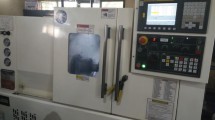Abstract
This study analyze the effect of machine tools, cooling lubrication environments and cutting conditions on surface roughness and cutting force, and propose the combination of cutting conditions which minimizes the effect of machine tool variables on the dispersion of cutting force and surface roughness by treating the changes in machine tool itself and the installation environments as a noise factors. To do so, the Taguchi method is used to establish an experiment plan, and flat end milling is carried out to measure cutting force and surface roughness. The research results show that in the case of cutting force, the effect of cutting conditions is dominant, and changes in machine tools and cooling lubrication environments barely have effect on cutting force. However, in the case of surface roughness, all of the cutting conditions, machine tool and cooling lubrication environment variables have impact. In order to select a combination of cutting conditions insensible to changes in machine tools, considerations for feed per revolution and axial depth of cut turn out most important in the aspect of cutting force, and considerations for feed per revolution is most important in the surface roughness.
Similar content being viewed by others
References
Yang, M. Y., “Metal cutting-principle and practice,” Cheongmoongak, pp. 143–161, 2001.
Boothroyd, G. and Knight, W. A., “Fundamentals of Machining and Machine Tools,” Tayler & Francis, pp. 165–316, 2006.
Hwang, Y. K., Chung, W. J. and Lee, C. M., “Experimental study of cutting force and surface roughness prediction in MQL turning of Al 6061,” Journal of the Korean Society for Precision Engineering, Vol. 25, No. 6, pp. 159–167, 2008.
Dhar, N. R., Islam, M. W., Islam, S. and Mithu, M. A. H., “The influence of minimum quantity of lubrication on cutting temperature, chip and dimensional accuracy in turning AISI-1040 steel,” Journal of Materials Processing Technology, Vol. 171, No. 1, pp. 93–99, 2006.
Dhar, N. R., Kamruzzaman, M. and Ahmed, M., “Effect of minimum quantity lubrication on tool wear and surface roughness in turning AISI-4340 steel,” Journal of Materials Processing Technology, Vol. 172, No. 2, pp. 299–304, 2006.
Attanasio, A., Gelfi, M., Giardini, C. and Remino, C., “Minimal quantity lubrication in turning: effect on tool wear,” International Journal on the Science and Technology of Friction, Lubrication and Wear, Vol. 260, No. 3, pp. 333–338, 2006.
Kang, M. C., Kim, J. S., Lee, D. W., Kim, K. H. and Ha, D. G., “Machinability evaluation according to variation of endmill shape for high speed machining,” Journal of the Korean Society for Precision Engineering, Vol. 19, No. 5, pp. 133–138, 2002.
Heo, S. J., “Hard turning machinability of V30 cemented carbide with PCD, cBN and PcBN cutting tool,” Journal of the Korean Society for Precision Engineering, Vol. 25, No. 12, pp. 47–54, 2008.
Rahman, M., Senthil, A. K. and Salam, M. U., “Experimental evaluation on the effect of minimal quantities of lubricant in milling,” International Journal of Machine Tools and Manufacture, Vol. 42, No. 5, pp. 539–547, 2006.
Changwon National University Machine Tool Research Center, “Development of Cutting Technology Using Minimum Quantity Lubrication,” Research report of the Changwon National University Machine Tool Research Center, 2005.
Nandi, A. K. and Davim, J. P., “A study of drilling performances with minimum quantity of lubricant using fuzzy logic rules,” Mechatronics, Vol. 19, No. 2, pp. 218–232, 2009.
Gaitonde, V. N., Karnik, S. R. and Davim, J. P., “Selection of optimal MQL and cutting conditions for enhancing machinability in turning of brass,” Journal of Materials Processing Technology, Vol. 204, No. 1–3, pp. 459–464, 2008.
Kishawy, H. A., Dumitrescu, M., Ng, E. G. and Elbestawi, M. A., “Effect of coolant strategy on tool performance, chip morphology and surface quality during high-speed machining of A356 aluminum alloy,” International Journal of Machine Tools and Manufacture, Vol. 45, No. 2, pp. 219–227, 2005.
Davim, J. P., Sreejith, P. S. and Silva, J., “Turning of brasses using minimum quantity of lubricant(MQL) and flooded lubricant conditions,” Materials and Manufacturing Processes, Vol. 22, No. 1, pp. 45–50, 2007.
Weinert, K., Inasaki, I., Sutherland, J. W. and Wakabayashi, T., “Dry machining and minimum quantity lubrication,” CIRP Annals-Manufacturing Technology, Vol. 53, No. 2, pp. 511–537, 2004.
Park, S. H., “Design of Experiments,” Minyoungsa, pp. 563–589, 2002.
Lee, S. H., “Data analysis of engineering statistics using MINITAB,” ERETEC, pp. 727–825, 2006.
Lion precision, “Instruction Manual of SEA Version 8,” Lion precision, pp. 3–8, 2006.
Tony, L. S., Jeremiah, C., Eric, M., Nathan, M. and Duke, H., “Run-out effects in milling: surface finish, surface location error, and stability” International Journal of Machine Tools and Manufacture, Vol. 47, No. 5, pp. 841–851, 2007.
Hwang, Y. K. and Lee, C. M., “A study on the spindle runout effects on cutter mark and surface roughness,” Transactions of the Korean Society of Machine Tool Engineers, Vol. 16, No. 2, pp. 84–91, 2007.
Edmund, I., “Engineering Formulas for Metal cutting,” Industrial Press, pp. 33–74, 2004.
Show, M. C., “Metal cutting principles,” Oxford University Press, pp. 432–477, 2005.
Author information
Authors and Affiliations
Corresponding author
Rights and permissions
About this article
Cite this article
Hwang, YK., Lee, CM. & Park, SH. Evaluation of machinability according to the changes in machine tools and cooling lubrication environments and optimization of cutting conditions using Taguchi method. Int. J. Precis. Eng. Manuf. 10, 65–73 (2009). https://doi.org/10.1007/s12541-009-0049-5
Received:
Accepted:
Published:
Issue Date:
DOI: https://doi.org/10.1007/s12541-009-0049-5




